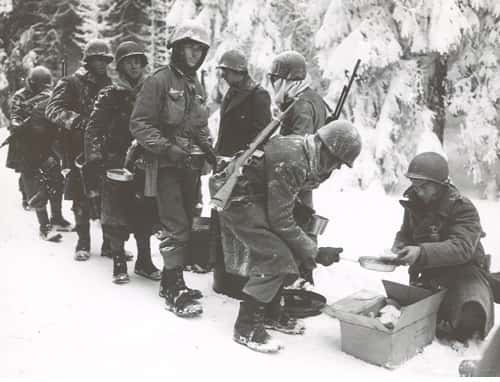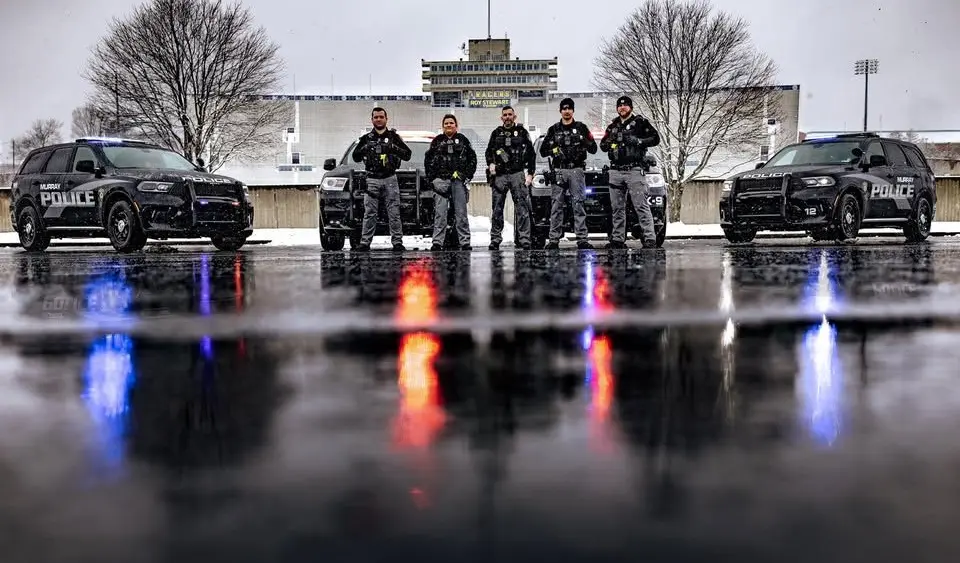“WHAT’S MERRY ABOUT ALL THIS, YOU ASK?”
Christmas at Bastogne
December 1944
Written by Justin Lamb

During the harsh blizzard of December 1944, German dictator Adolph Hitler ordered his army to stage a major surprise offensive in Ardennes Mountains in Belgium in an attempt to split the Allied armies in northwest Europe. What followed was one of the most horrific battles of World War II, and with over 100,000 casualties, the Battle of the Bulge beginning on December 16 was the deadliest action ever fought by the United States Army during the war.
In the brutal cold weather with eight inches of snow on the ground and temperatures reaching thirty below, American troops were faced with deplorable conditions. For the German Army, the capture of Bastogne, Belgium was the ultimate goal of the Battle of the Bulge because it provided a road junction and the possibility of opening up a valuable pathway further north for German expansion.
Outnumbered but holding firm against the mighty German advances in Bastogne was the U.S. 101st Airborne Division. As the Germans continued brutal assaults on the American forces, food and other supplies became scarce which threatened the American ability to hold out. When the Germans demanded the surrender of the American soldiers on December 22, Brigadier General Anthony C. MacAullife responded with a typewritten not with a single word reading “Nuts.” For the Germans who did not understand the American colloquialism, Lt. Colonel Joseph Harper explained: “It means the same thing as ‘Go to hell!”
For the Christmas season of 1944, the American soldiers of Bastogne spent the harsh holiday barely holding the Germans back from their advance through Belgium as hope continued to bleak. According to the National Review, “The Americans were undersupplied and outnumbered. The weather was miserable, frigid and snowy, with cloud cover denying the Allies their advantage in the air.” Thankfully, the weather briefly broke on December 23 allowing American planes to attack the German soldiers and to drop much needed supplies to the American troops below. However, the Germans prepared another heavy assault on Christmas Eve as many of the American soldiers believed they wouldn’t survive the Christmas holiday.
To revive his troop’s morale, General MacAullife gave his now legendary Christmas Eve message at Bastogne:
“What’s Merry about all this, you ask? We’re fighting – it’s cold – we aren’t home. All true but what has the proud Eagle Division accomplished with its worthy comrades of the 10th Armored Division, the 705th Tank Destroyer Battalion and all the rest? Just this: We have stopped cold everything that has been thrown at us from the North, East, South and West. We have identifications from four German Panzer Divisions, two German Infantry Divisions and one German Parachute Division. These units, spearheading the last desperate German lunge, were headed straight west for key points when the Eagle Division was hurriedly ordered to stem the advance. How effectively this was done will be written in history; not alone in our Division’s glorious history but in World history. The Germans actually did surround us. Their radios blared our doom. Their Commander demanded our surrender in the following impudent arrogance. Allied Troops are counterattacking in force. We continue to hold Bastogne. By holding Bastogne we assure the success of the Allied Armies. We know that our Division Commander, General Taylor, will say: Well Done! We are giving our country and our loved ones at home a worthy Christmas present and being privileged to take part in this gallant feat of arms are truly making for ourselves a Merry Christmas.”
On the day after Christmas, the American troops received their Christmas gift when General George Patton wheeled his 3rd army in a counterthrust movement to break through the German lines and entered Bastogne for much needed relief to the 101st. The move turned the tide of the battle and eventually forced the Germans to move back across the Rhine.
After a month of extreme battle, American casualties mounted to nearly 77,000 and several men were captured as prisoners of war. One solider, Marshall Countian, PFC Grover H. Wolfe, was a paratrooper with the 101st and was captured on Christmas at Bastogne. He was wounded in the right leg by a piece of Nazi mortar shrapnel. He survived the war and returned home in 1945 following Germany’s surrender.






